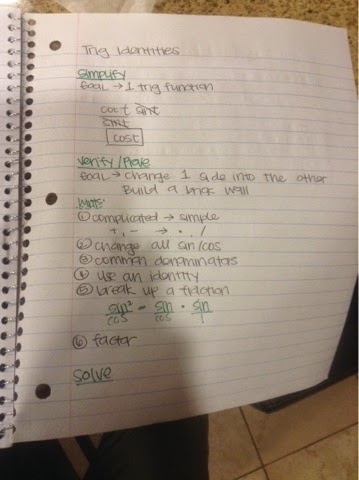Ps... C is for Confidence!!!
Audrey's Blog
Friday, May 8, 2015
Summary of 2nd Semester #15
This semester was pretty good. However, I am disappointed in myself for my grade, but you were a fantastic teacher. Thank you so much for putting time and effort into my learning. I am really sad that I won't have you next year, and I'm scared of Mrs. Peltier (tbh). You are such an awesome teacher and I have learned so much from you and I enjoyed your class. I, personally, do not have anything bad to say about your class. It was a challenge, but it was a need one. Math is tough, but you made it fun and continue to do what you are doing, because I know students love your class.
Trig Identities #14
Your goal to simplifying trig functions is to end with one trig function. To do that, use trig identities, which cancel out some parts of the function. Your goal to verifying is to change one side into the other. One key is to build a brick wall. One hint isto start with the complicated side. Then, change all sines and cosines. Then, find denominators and use an identity. Finally, break up a fraction and factor. To simplify, use the unit circle and have all the same trig functions. Then, factor and DO NOT divide and cancel!
Tuesday, May 5, 2015
Repeating Decimals #13
Repeating decimals are fun! Every repeating decimal is the sum of an infinite geometric series. The key to finding the answer is to write the decimal all as a quotient of integers. In other words, as a fraction. An example would be...
Given: 0.232323...
First step: write as a geometric series
0.23 + 0.0023 + 0.000023 + 0.00000023 + ...
Second step: find the sum
23/100 + 23/10,000 + 23/1,000,000 + ...
r(the pattern) = 1/100
Use the formula S = a/1-r
S = (23/100)/(1-(1/100)) = (23/100)/(99/100) = 23/99
Parametric Equations #12
The first step to solving a parametric equation is to sketch the graph. Making a table helps. Then eliminate the parameter by using substitution, elimination, and trig identities. When it comes to solving, always eliminate "t." The parameter = t. In every set of equations, an interval is given. A key is to look for a trig identity that only has the sin, cos, or tan in the equation.
Saturday, May 2, 2015
Partial Fractions #11
There are three set up steps for partial fraction decomposition. 1. Divide if it is improper. 2. Factor he denominator. 3. If it is linear, add A,B,C...etc. If it is quadratic, add Ax+B, Cx+D...etc. Then, there are four steps for solving. 1. Multiply by the least common denominator. 2. Group the terms by powers of x. 3. Equate the coefficients. 4. Solve the system of equations.
Graphing Systems of Inequalities #8
For graphing systems of Inequalities, there are three steps. 1. Graph each equation based upon if it is a line, parabola, or circle. The equation for a line is y=mx+b. The equation for a parabola is y=(x-h)^2+k. The equation for a circle is x^2+y^2=r^2. 2. Pick a test point not on the line. 3. Shade the plane containing the test point, if the test point satisfies the equation, shade the other plane if it does not.
Sequences and Series #9
A sequence is a particular order in which related events, movements, or things follow each other. A series is a number of things, events, or people of a similar kind or related nature coming one after another. There are two types of series: arithmetic and geometric. Arithmetic is when numbers are added or subtracted. To find the sum of an arithmetic series, use the formula Sn=n(a1+a2/2). To fund the sum of a geometric series, use the formula Sn=a1(1-r^2)/1-r. Geometric is when numbers are multiplied or divided.
Subscribe to:
Comments (Atom)






